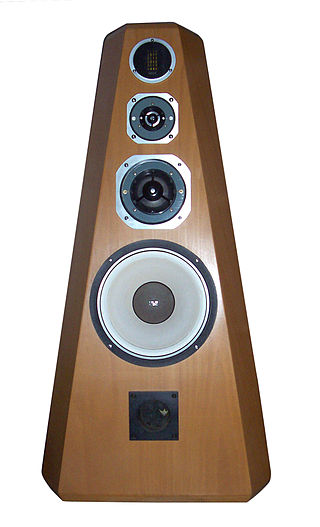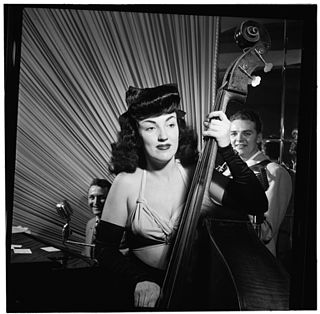
Acoustics is a branch of physics that deals with the study of mechanical waves in gases, liquids, and solids including topics such as vibration, sound, ultrasound and infrasound. A scientist who works in the field of acoustics is an acoustician while someone working in the field of acoustics technology may be called an acoustical engineer. The application of acoustics is present in almost all aspects of modern society with the most obvious being the audio and noise control industries.

High fidelity is the high-quality reproduction of sound. It is popular with audiophiles and home audio enthusiasts. Ideally, high-fidelity equipment has inaudible noise and distortion, and a flat frequency response within the human hearing range.

A Shepard tone, named after Roger Shepard, is a sound consisting of a superposition of sine waves separated by octaves. When played with the bass pitch of the tone moving upward or downward, it is referred to as the Shepard scale. This creates the auditory illusion of a tone that seems to continually ascend or descend in pitch, yet which ultimately gets no higher or lower.

Pitch is a perceptual property that allows sounds to be ordered on a frequency-related scale, or more commonly, pitch is the quality that makes it possible to judge sounds as "higher" and "lower" in the sense associated with musical melodies. Pitch is a major auditory attribute of musical tones, along with duration, loudness, and timbre.
Auditory illusions are false perceptions of a real sound or outside stimulus. These false perceptions are the equivalent of an optical illusion: the listener hears either sounds which are not present in the stimulus, or sounds that should not be possible given the circumstance on how they were created.

Binaural recording is a method of recording sound that uses two microphones, arranged with the intent to create a 3D stereo sound sensation for the listener of actually being in the room with the performers or instruments. This effect is often created using a technique known as dummy head recording, wherein a mannequin head is fitted with a microphone in each ear. Binaural recording is intended for replay using headphones and will not translate properly over stereo speakers. This idea of a three-dimensional or "internal" form of sound has also translated into useful advancement of technology in many things such as stethoscopes creating "in-head" acoustics and IMAX movies being able to create a three-dimensional acoustic experience.
An audiophile is a person who is enthusiastic about high-fidelity sound reproduction. An audiophile seeks to reproduce recorded music to achieve high sound quality, typically in a quiet listening space and in a room with good acoustics.
Sound can be recorded and stored and played using either digital or analog techniques. Both techniques introduce errors and distortions in the sound, and these methods can be systematically compared. Musicians and listeners have argued over the superiority of digital versus analog sound recordings. Arguments for analog systems include the absence of fundamental error mechanisms which are present in digital audio systems, including aliasing and associated anti-aliasing filter implementation, jitter and quantization noise. Advocates of digital point to the high levels of performance possible with digital audio, including excellent linearity in the audible band and low levels of noise and distortion.

The pitch being perceived with the first harmonic being absent in the waveform is called the missing fundamental phenomenon.

The tritone paradox is an auditory illusion in which a sequentially played pair of Shepard tones separated by an interval of a tritone, or half octave, is heard as ascending by some people and as descending by others. Different populations tend to favor one of a limited set of different spots around the chromatic circle as central to the set of "higher" tones. Roger Shepard in 1963 had argued that such tone pairs would be heard ambiguously as either ascending or descending. However, psychology of music researcher Diana Deutsch in 1986 discovered that when the judgments of individual listeners were considered separately, their judgments depended on the positions of the tones along the chromatic circle. For example, one listener would hear the tone pair C–F♯ as ascending and the tone pair G–C♯ as descending. Yet another listener would hear the tone pair C–F♯ as descending and the tone pair G–C♯ as ascending. Furthermore, the way these tone pairs were perceived varied depending on the listener's language or dialect.

A hearing test provides an evaluation of the sensitivity of a person's sense of hearing and is most often performed by an audiologist using an audiometer. An audiometer is used to determine a person's hearing sensitivity at different frequencies. There are other hearing tests as well, e.g., Weber test and Rinne test.

Within ghost hunting and parapsychology, electronic voice phenomena (EVP) are sounds found on electronic recordings that are interpreted as spirit voices. Parapsychologist Konstantīns Raudive, who popularized the idea in the 1970s, described EVP as typically brief, usually the length of a word or short phrase.

Stereophonic sound, or more commonly stereo, is a method of sound reproduction that recreates a multi-directional, 3-dimensional audible perspective. This is usually achieved by using two independent audio channels through a configuration of two loudspeakers in such a way as to create the impression of sound heard from various directions, as in natural hearing.

Sub-bass sounds are the deep, low-register pitches below approximately 70 Hz (C♯2 in scientific pitch notation) and extending downward to include the lowest frequency humans can hear, approximately 20 Hz (E0).

A headphone amplifier is a low-powered audio amplifier designed particularly to drive headphones worn on or in the ears, instead of loudspeakers in speaker enclosures. Most commonly, headphone amplifiers are found embedded in electronic devices that have a headphone jack, such as integrated amplifiers, portable music players, and televisions. However, standalone units are used, especially in audiophile markets and in professional audio applications, such as music studios. Headphone amplifiers are available in consumer-grade models used by hi-fi enthusiasts and audiophiles and professional audio models, which are used in recording studios.

Hearing range describes the frequency range that can be heard by humans or other animals, though it can also refer to the range of levels. The human range is commonly given as 20 to 20,000 Hz, although there is considerable variation between individuals, especially at high frequencies, and a gradual loss of sensitivity to higher frequencies with age is considered normal. Sensitivity also varies with frequency, as shown by equal-loudness contours. Routine investigation for hearing loss usually involves an audiogram which shows threshold levels relative to a normal.

In sound recording and reproduction, audio mixing is the process of optimizing and combining multitrack recordings into a final mono, stereo or surround sound product. In the process of combining the separate tracks, their relative levels are adjusted and balanced and various processes such as equalization and compression are commonly applied to individual tracks, groups of tracks, and the overall mix. In stereo and surround sound mixing, the placement of the tracks within the stereo field are adjusted and balanced. Audio mixing techniques and approaches vary widely and have a significant influence on the final product.

An assistive listening device (ALD) is part of a system used to improve hearing ability for people in a variety of situations where they are unable to distinguish speech in noisy environments. Often, in a noisy or crowded room it is almost impossible for an individual who is hard of hearing to distinguish one voice among many. This is often exacerbated by the effect of room acoustics on the quality of perceived speech. Hearing aids are able to amplify and process these sounds, and improve the speech to noise ratio. However, if the sound is too distorted by the time it reaches the listener, even the best hearing aids will struggle to unscramble the signal. Assistive listening devices offer a more adaptive alternative to hearing aids, but can be more complex and cumbersome.
Psychoacoustics is the branch of psychophysics involving the scientific study of sound perception and audiology—how the human auditory system perceives various sounds. More specifically, it is the branch of science studying the psychological responses associated with sound. Psychoacoustics is an interdisciplinary field including psychology, acoustics, electronic engineering, physics, biology, physiology, and computer science.
Covfefe is a word, widely presumed to be a typographical error, that Donald Trump used in a viral tweet when he was President of the United States. It instantly became an Internet meme.















